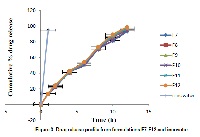n Vitro and In Vivo Evaluation of Quetiapine Fumarate controlled gastroretentive floating drug delivery system
Keywords:
Quetiapine fumarate, Floating drug delivery system, HPMC, Polyox WSR 301, Radiographic studiesAbstract
The aim of the present work was to develop and optimize gastroretentive floating system of Quetiapine fumarate (QF) for the effective treatment of Schizophrenia. The present study was carried out with an objective of preparation and in vivo evaluation of floating tablets of using QF as a model drug using HPMC polymers, Gelucire 43/01 and Polyox WSR 301 to improve oral bioavailability of QF floating tablets by increasing gastric residence time. The tablets were prepared by direct compression method. The effect of polymers concentration and viscosity grades of HPMC on drug release profile was evaluated. The result of in vitro dissolution study showed that the drug release profile could be sustained by increasing the concentration of HPMC K15M and Polyox WSR 301. The optimized formulation (F12) containing HPMC K15M and Polyox WSR301 showed 98.6% drug release at the end of 12h. Changing the viscosity grade of HPMC from K15M to K100M had no significant effect on drug release profile. The optimized formulations (F12) containing sodium bicarbonate 40mg per tablet showed desired buoyancy (floating lag time of about 32seconds and total floating time of >12h). Optimized formulation (F12) followed diffusion controlled zero order kinetics and non-fickian transport of the drug. FTIR and DSC studies revealed the absence of any chemical interaction between drug and polymers used. The best formulation (F12) was selected based on in vitro characteristics and was used in vivo radiographic studies by incorporating BaSO4. These studies revealed that the tablets remained in the stomach for 6h in fasting human volunteers and indicated that gastric retention time was increased by the floating principle, which was considered desirable for the absorption window drugs. Studies to evaluate the pharmacokinetics in vivo showed better bioavailability, area under the concentration–time curve, elimination rate constant and half-life than marketed product.
References
. Rouge N, Buri P, Doelker E. Drug absorption sites in the gastrointestinal tract and dosage forms for site specific delivery. Int J Pharm. 1996; 136: 117-139.
. Singh BN, Kim KH. Floating drug delivery systems: an approach to oral controlled drug delivery via gastric retention. J. Control Release. 2000; 63: 235-239.
. Harshal P, Gahiwade V, Manohar P, Bharat Tekade W, Vinod Thakare M, Patil V R. formulation and in-vitro evaluation of trifluoperazine hydrochloride bilayer floating tablet. Int J of Phar Bio Sic. 2012; 2 (1): 166-172.
. Tadros MI. Controlled-release effervescent floating matrix tablets of ciprofloxacin hydrochloride: development, optimization and in vitro-in vivo evaluation in healthy human volunteers. Eur J Pharm and Biopharm. 2010; 74: 332–33.
. Sarfaraz Md, Keerthi Chandra Reddy P, Udupi R H, Doddayya H. Formulation and In-Vitro Evaluation of Bilayer Floating tablets of Tramadol Hydrochloride. Int j of drug dev and res. 2012; 4 (3): 335-347.
. Rajani S, Ranendra Saha T N. In vitro and in vivo evaluation of gastroretentive floating drug delivery system of ofloxacin. Asian J of Pharma Sci. 2013; 8 (3): 191-198.
. Mohan G, Ramesh B, Kishan V. Development of sustained release floating drug delivery system for norfloxacin: In vitro and in vivo evaluation. PDA J of Pharma sci and tech. 2011; 65: 198-206.
. Streubel A, Siepmann J, Bodmeier R. Floating matrix tablets based on low density foam powder: effects of formulation and processing parameters on drug release. Eur. J. Pharm. Sci. 2003; 18 (1): 37– 45.
. Nirav Sheth S. Formulation and evaluation of floating drug delivery system Int of Pharma and Bio Sci. 2011; 2 (1): 571-80.
. Mullen J, Jibson MD, Sweitzer D. A comparison of the relative safety, efficacy, and tolerability of quetiapine and risperidone in outpatients with schizophrenia and other psychotic disorders: the quetiapine experience with safety and tolerability (QUEST) study. Clin Ther. 2001; 23: 1839-54.
. Tadros M. Eur J of Pharma and Biopharma. Controlled-release effervescent floating matrix tablets of ciprofloxacin hydrochloride: Development, optimization and in vitro-in vivo evaluation in healthy human volunteers.2010; 74: 332–339.
. Higuchi T, Mechanism of sustained action medication theoretical analysis of rate of release of solid drugs dispersed in solid matrices. J Pharm Sci, 1961, 50, 874-875.
. Siepmann J, Peppas N.A. Modeling of drug release from delivery systems based on hydroxypropyl methylcellulose (HPMC). Adv Drug Delivery Reviews. 2001; 48: 139-157.
. Garg R, Gupta GD. Progress in Controlled Gastroretentive Delivery Systems. Trop J of Pharm Res. 2008; 7 (3): 1055-1066.
. Anand Patel. Development and In Vivo Floating Behavior of Verapamil HCl Intragastric Floating Tablets. AAPS PharmSciTech. 2009; 10(1): 310-315.
. Prasanna Kumari J, Ramarao T, Jayaveera K N, Bhikshapathi D V R N, Madhusudan Rao Y. Design and In vivo evaluation of Metoprolol Tartrate bilayer floating tablets in healthy human volunteers. Int J of Drug Delivery. 2014; 6: 14-23.
. Kiran B. V, Sreenivas Rao B, Somshankar D. Validation of Quetiapine Fumarate in Pharmaceutical Dosage by Reverse-Phase HPLC with Internal Standard Method, J of Chemistry. 2013; Article ID 578537.






